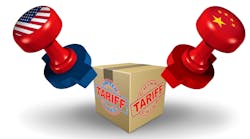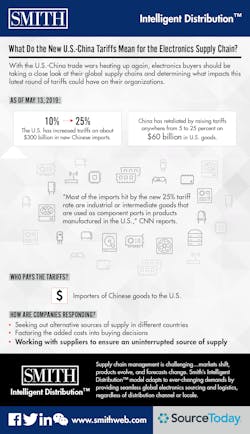With the U.S.-China trade wars heating up again, electronics buyers should be taking a close look at their global supply chains and determining what impacts this latest round of tariffs could have on their organization.
The situation remains in flux as U.S. and Chinese governments grapple over the issue, but as of May 13, President Trump has ordered increased tariffs (from 10% to 25%) on about $300 billion in new Chinese imports (essentially, all imports that weren’t already subject to the higher tariffs), and the Chinese have retaliated by raising tariffs on $60 billion in U.S. goods.
“Most of the imports hit by the new 25% tariff rate are industrial or intermediate goods that are used as component parts in products manufactured in the U.S.,” CNN reports, noting that the new list also includes luggage, backpacks, baseball gloves, bamboo furniture, chandeliers, sailboats, motorboats, canoes, and parking meters.
Who Pays the Tariffs?
A tax on imports, tariffs are paid to the U.S. government by importing companies, most of which are either U.S. companies or the U.S.-registered units of foreign companies that import goods from China, Reuters explains.
According to Wired, the new tariffs could hit tech-related companies pretty hard. “Many U.S. semiconductor companies, for instance, are heavily exposed to China, both in terms of what they sell in China and how much they manufacture in China and then ship to the US,” Zachary Karebell writes.
“Qualcomm and Broadcom, for instance, generate more than 60 percent of their revenue from China, and are at risk from China’s retaliatory tariffs,” he points out. “And while companies such as Apple have not been affected by tariffs to date, Trump’s [25% tariffs] on additional Chinese imports would mean that all those iPhones assembled in Shenzhen would suddenly become even more expensive.”
Impact on Electronics
With this latest round of tariffs, the companies that import their industrial electronic parts from China may need to adjust their procurement strategies to accommodate the higher import costs. Those strategies could include seeking out alternative sources of supply in different countries (something many companies have been doing since the trade wars started surfacing last year); factoring the added costs into buying decisions; and/or working with suppliers to ensure an uninterrupted source of supply.
Many U.S. manufacturers are talking openly about their tariff struggles and how they’re offsetting them. Harley-Davidson, for example, has said that tariffs in the U.S., China, and Europe will cost the company up to $120 million this year. The company is ramping up production in Thailand to help lower costs, CNN reports.
In “The U.S.-China trade war is disrupting global supply chains in surprising ways,” Akiko Fujita explains how electronics manufacturer Audio Control is shifting its supply chain away from China. “We’ve started. We have plans in place, we’re working through that with two or three Chinese companies that supply product because we can’t wait to suddenly find out, by the way the tariffs are now 25% or something,” Audio Control’s Alex Camara told Yahoo! Finance.
According to Fujita, the manufacturer sources 70% of its components from U.S. suppliers. But when the first 10% tariff was placed on $200 billion in Chinese goods in 2018, the company’s costs jumped. “Everything from resistors to the diodes he imported were all taxed,” she writes, “resulting in a $200,000 bill, for the small business so far.”
Staying Resilient
In a webinar last week, the Institute for Supply Management (ISM) addressed concerns about the new levy’s effect on the economy, procurement, and supply chains. “I was hoping we wouldn’t still be talking about tariffs, but alas we still are,” ISM’s Timothy Fiore said.
During the webinar, Fiore praised supply chain professionals for being resilient in times like these and finding solutions that can reduce costs for businesses, Spend Matters reports, noting that one tactic is to move production out of high-tariff areas.
“Alternate supply routes are an option,” he said. “The challenge is that once you change supply chain routes and the price points are good, then the supply chains won’t go back to where they were.”











